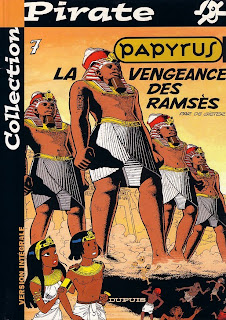 From the futuristic Aldebaran via the contemporary Lady S to Biggles flying in World War II skies, downthetubes’ reviews of Cinebook graphic novels have been moving backwards through time and the theme continues with the Papyrus book, The Rameses’ Revenge
From the futuristic Aldebaran via the contemporary Lady S to Biggles flying in World War II skies, downthetubes’ reviews of Cinebook graphic novels have been moving backwards through time and the theme continues with the Papyrus book, The Rameses’ Revenge.
Papyrus is a young Egyptian fisherman who, having been given a magical sword by the crocodile goddess Sobek, must protect the Pharaoh’s young daughter Theti-Cheri from danger. The Rameses’ Revenge tells of Papyrus and Theti-Cheri traveling up the Nile with the Pharaoh to visit the temple of Rameses at Abu Simbel. The Pharaoh stops at the last town before Abu Simbel but Theti-Cheri decides to press on and arrive at the temple before her father. However Papyrus has been having visions of Theti being in danger, visions which prove to be correct as robbers have seized control of the temple and take her prisoner.
Originally published in 1984 in the weekly comic Spirou, Papyrus is humorous fantasy aimed at a younger audience. With the cover showing enormous walking statues and the book beginning with Papyrus being attacked by a sea monster, writer and artist Lucien de Gieter uses the mystical elements of the real ancient Egyptians’ religion to boost his story.
Theti-Cheri’s father is the real Pharaoh Merneptah of Nineteenth Dynasty Egypt which places the story at around 1210BC. While the Pharaoh would not have had a daughter with a half Egyptian half French name, “Darling Theti”, the series benefits from the historical research de Gieter put into it. The real temple at Abu Simbel built by Rameses II, also known as Rameses the Great, is where much of the action takes place in the second half of the story. Historically Rameses II was the father of Merneptah and therefore the grandfather of the fictional Theti-Cheri while the damage that we see on one of the four statues at the real Abu Simbel today becomes a plot point in the book.
 Althothough The Rameses’ Revenge
Althothough The Rameses’ Revenge is the first of the 30 Papyrus albums to be translated into English by Cinebook, the title was actually the seventh Papyrus album, La Vengeance Des Ramsès, originally published as an album by Dupuis in France, and as such explains nothing of the background to the characters. While Cinebook do have a short explanation to set the scene, it’s on the back cover of the book and considering that the vast majority of readers will know nothing of the characters it is fairly important to their understanding of what is going on to read it first. It would perhaps have been beneficial to have it inside the book before the first page of the story in a similar way to way the Asterix books introduce their characters.
The one thing to remember here of course is that despite the historical elements this is a tongue-in-cheek adventure story in a similar vein to Tintin. De Gieter’s art covers the accuracy required in showing the real world places that the characters inhabit whilst drawing the characters in a style similar to Asterix. This may sound incongruous but it does work within the confines of the story while the plot rattles along with enough going on, including several twists once the characters have reached Abu Simbel, to keep adults as well as children both interested and amused.
Categories: Reviews
 Five Weird Comic Book Crossovers That Worked
Five Weird Comic Book Crossovers That Worked  In Review: The Running Man
In Review: The Running Man  Making the Most of the Thought Bubble Comic Convention
Making the Most of the Thought Bubble Comic Convention  In Review: Scream – The Specials 1985-2024
In Review: Scream – The Specials 1985-2024